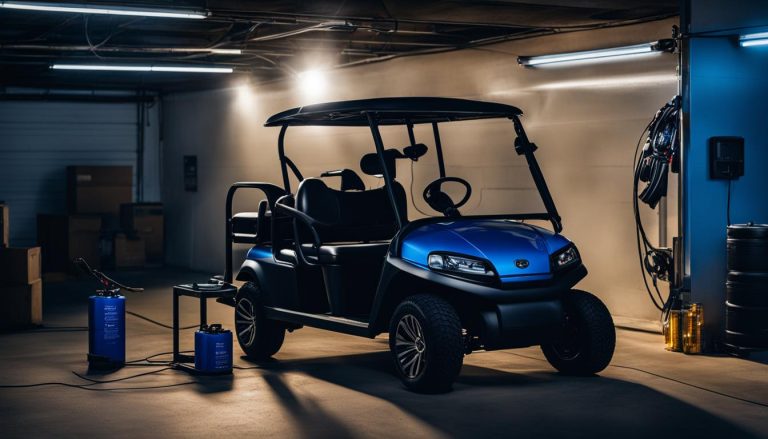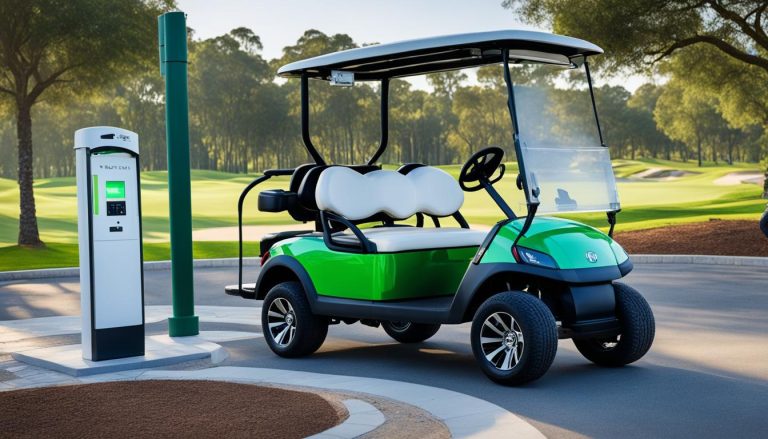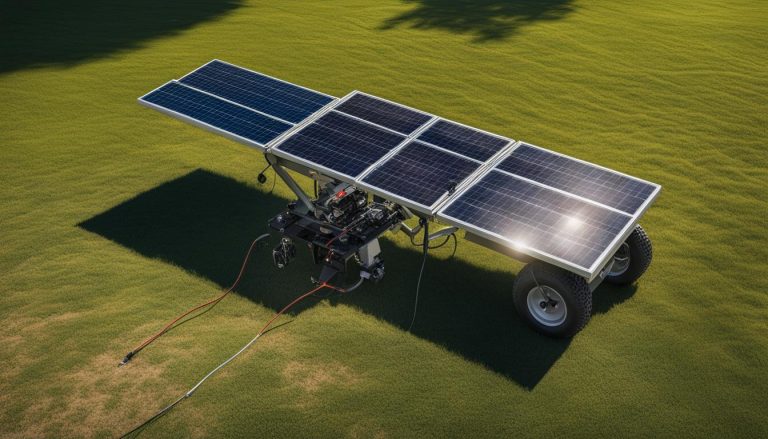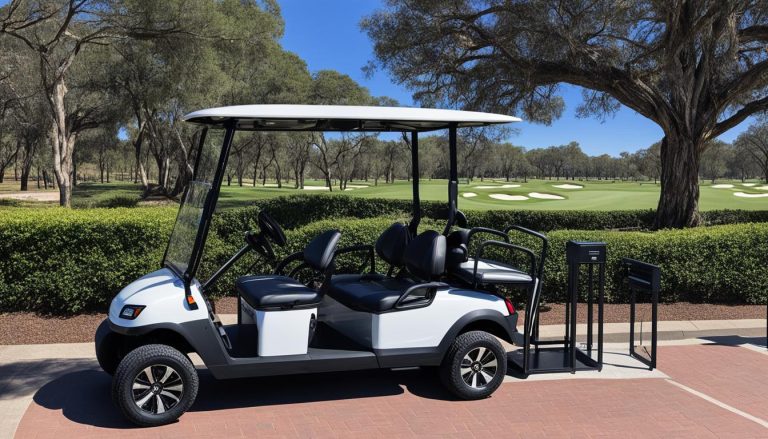Optimal Charging for Golf Cart Batteries Explained
batterychargers.site and its partners may earn a commission if you purchase a product through one of our links
Golf cart batteries are the lifeblood of your trusty ride on the green, and ensuring they are properly charged is key to keeping your golf cart running smoothly. But how often should you charge your golf cart batteries? What’s the optimal charging frequency? In this guide, we’ll answer these questions and more, providing you with the best practices for charging golf cart batteries.
When it comes to charging golf cart batteries, there is no one-size-fits-all approach. The ideal charging interval can vary depending on several factors, including the type of battery and charger you have, as well as external influences such as weather conditions. Let’s dive into the details to help you optimize your golf cart battery charging schedule.
Key Takeaways:
- Understanding the optimal charging frequency for your golf cart batteries is crucial for maintaining their performance and longevity.
- Battery type plays a significant role in determining charging times, with lithium batteries offering faster charging and longer lifespan compared to traditional lead-acid batteries.
- The type of charger used also affects the charging duration, with smart chargers and fast chargers offering quicker charging times.
- Avoid overcharging and undercharging your batteries as it can impact their lifespan and performance. Optimal battery maintenance includes charging after each use and avoiding deep discharges.
- External factors, such as weather and temperature, can influence battery charging. Creating an optimal charging environment is essential for maximizing battery health and performance.
Understanding Battery Types and Their Charging Times
The type of battery used in your golf cart can significantly impact its charging time. Let’s compare the two main battery types commonly used in golf carts: lead-acid batteries and lithium batteries. Understanding their differences will help you make an informed decision for your golf cart.
Lead-Acid Batteries
Lead-acid batteries have been the go-to choice for golf carts for many years. They are reliable and cost-effective, making them a popular option among golf cart owners. However, one downside of lead-acid batteries is their extended charging time.
Lead-acid batteries typically require a longer charging time due to their chemistry. Expect a full charge to take around 8 to 10 hours, depending on the battery’s capacity and the charger’s efficiency.
Lithium Batteries
Lithium batteries are revolutionizing the golf cart industry. They offer several advantages over traditional lead-acid batteries. Notably, lithium batteries provide faster charging times, allowing you to get back on the course sooner.
Unlike lead-acid batteries, lithium batteries can be charged at a much faster rate. With the right charger, it’s possible to recharge a lithium battery to full capacity in as little as 2 to 4 hours, depending on the battery size and charger capabilities.
Lithium batteries also have a longer lifespan compared to lead-acid batteries. They can endure thousands of charge cycles, whereas lead-acid batteries typically last for a few hundred cycles.
Overall, lithium batteries offer a more efficient and convenient charging experience for golf cart owners.
“Lithium batteries provide faster charging times, allowing you to get back on the course sooner.”
So, when it comes to charging times, lithium batteries outperform lead-acid batteries. If you’re looking for quicker recharge times and enhanced battery longevity, investing in lithium batteries may be the right choice for your golf cart.
Charger Types and Their Role in Charging Times
When it comes to charging golf cart batteries, the type of charger you use can significantly impact the charging time. Let’s explore the different charger types available and their role in determining the duration of the charging process.
Standard Chargers
Standard chargers are the most common type of charger used for golf cart batteries. These chargers deliver a consistent power output, allowing for a reliable and steady charge. However, it’s important to note that standard chargers may have longer charging times compared to other charger types.
Fast Chargers
If you’re looking to reduce your golf cart charging time, fast chargers are a great option. These chargers provide a higher power output, enabling faster and more efficient charging. With fast chargers, you can quickly get your golf cart back on the green and continue enjoying your game.
Smart Chargers
Smart chargers are the latest innovation in golf cart battery charging. These chargers are designed with advanced technology that monitors and adjusts the charging process based on the battery’s specific needs. Smart chargers optimize the charging time by delivering the right amount of power at the right time, ensuring efficient and safe charging.
When selecting a charger for your golf cart batteries, it’s essential to consider charger compatibility. Using a charger that is specifically designed for your battery type will not only ensure faster charging times but also prevent potential damage to the batteries.
Now, let’s take a look at the estimated charging times for each charger type:
| Charger Type | Charging Time |
|---|---|
| Standard Charger | 4-8 hours |
| Fast Charger | 2-4 hours |
| Smart Charger | 3-6 hours |
As you can see, fast chargers offer the shortest charging time, followed closely by smart chargers. Standard chargers, while widely used, generally require a longer charging period. Keep in mind that these are estimated charging times and can vary depending on factors such as battery capacity, charging conditions, and the battery’s overall health.
Understanding charger types and their impact on charging times is crucial for optimizing your golf cart battery charging process. By selecting the right charger and ensuring compatibility with your battery, you can significantly reduce downtime and get back to enjoying your golf cart adventures sooner.
Managing Overcharging and Undercharging
Properly managing the charge levels of your golf cart batteries is crucial for ensuring their longevity and optimal performance. Overcharging and undercharging can have significant effects on the battery lifespan, performance, and capacity. To get the most out of your golf cart batteries, it’s important to follow these maintenance tips:
Effects of Overcharging
Overcharging your golf cart batteries can lead to reduced battery lifespan and performance. The excess electrical charge causes the battery to heat up, accelerating the chemical reactions inside the battery. This can result in the battery plates corroding faster, diminishing its capacity over time. Overcharging can also cause electrolyte loss, leading to irreversible damage to the battery.
Effects of Undercharging
On the other hand, undercharging can also negatively impact battery performance and capacity. When a battery isn’t fully charged, sulfation can occur on the battery plates. This sulfation leads to a loss of active material, reducing the battery’s overall capacity. Undercharging can also result in stratification, where the battery acid concentration becomes imbalanced, further compromising battery performance.
To maintain optimal battery health and performance, follow these tips:
- Charge after each use: It’s important to recharge your golf cart batteries after each use, even if you only travel short distances. This helps prevent undercharging and ensures your batteries are always ready for the next outing.
- Avoid deep discharges: Deep discharging, where the battery charge drops to a very low level, can cause irreversible damage to the battery. Try to avoid letting your batteries reach a critically low charge level to extend their lifespan.
“Proper maintenance and charging practices are key to maximizing the lifespan and performance of your golf cart batteries.”
By following these guidelines, you can ensure that your golf cart batteries remain in optimal condition, delivering reliable performance and lasting for a longer period.

Effects of Overcharging and Undercharging
| Issue | Effects |
|---|---|
| Overcharging | Reduced battery lifespan and performance, corrosion of battery plates, electrolyte loss |
| Undercharging | Loss of battery capacity, sulfation, stratification |
External Factors Affecting Battery Charging
When it comes to charging your golf cart batteries, external factors can play a crucial role. Weather conditions and temperature can significantly impact the charging process, affecting battery health, performance, and capacity.
Let’s start by exploring the weather’s impact on battery charging. Extreme temperatures, such as severe cold or hot weather, can slow down the charging process. Cold temperatures, for example, can cause the chemical reactions within the battery to slow down, resulting in a longer charging time. On the other hand, high temperatures can increase the battery’s internal resistance, making it less efficient to charge.
The temperature influence on battery charging should not be overlooked. Ideally, batteries should be charged in a moderate temperature range, typically between 50°F and 80°F (10°C and 27°C). This optimal charging environment ensures that the battery charges efficiently and maintains its performance and capacity.
Battery Charging Efficiency
An optimal charging environment not only improves battery health and performance but also enhances the overall battery charging efficiency. When batteries are charged in the recommended temperature range, the chemical reactions occur more effectively, resulting in a faster and more efficient charging process.
However, if the temperature is too low or too high, the charging efficiency may decrease, and it can take longer to charge the batteries fully. This inefficient charging can not only be time-consuming but may also negatively impact the battery’s lifespan and capacity.
Creating an Optimal Charging Environment
To optimize your battery charging process, it’s important to create an ideal charging environment. Here are a few tips to help you achieve this:
- Charge your golf cart batteries in a sheltered area, away from direct sunlight and extreme temperatures.
- Consider using a battery charging station or a climate-controlled battery storage area, especially in regions with fluctuating or extreme weather conditions.
- Regularly inspect the battery charging area for any signs of damage or hazards that could affect the charging process.
By following these recommendations, you can create an optimal charging environment that promotes battery health and maximizes charging efficiency.

“Optimizing the charging environment is essential for maintaining battery health and performance. By considering external factors like weather and temperature, you can ensure that your golf cart batteries charge efficiently and last longer.”
As you can see, external factors like weather and temperature can have a significant impact on battery charging. Creating an optimal charging environment is crucial for maximizing battery health, performance, and capacity. By following the recommended guidelines and taking proactive measures, you can ensure that your golf cart batteries are always operating at their best.
Troubleshooting Slow Charging Issues
Slow charging issues can be frustrating for golf cart owners. If you’re experiencing slow charging problems with your golf cart batteries, it’s essential to troubleshoot the issue promptly. Let’s explore some common troubleshooting steps to help you identify and resolve the slow charging problems.
Regular Battery Maintenance
One of the primary causes of slow charging issues is poor battery maintenance. Regular battery maintenance is crucial to ensure optimal charging performance. Here are some essential maintenance tips:
- Keep your batteries clean by wiping away any dirt or debris that may have accumulated on the battery surface.
- Check and tighten battery connectors to ensure a secure electrical connection.
- Inspect the overall battery health regularly to identify any signs of damage or deterioration.
Diagnosing Battery Health
Before troubleshooting slow charging issues, it’s important to perform a battery health check. You can use a battery tester or a voltmeter to measure the voltage of each battery in your golf cart. A healthy battery should have a voltage reading within the manufacturer’s recommended range. If any battery falls below the specified voltage, it may need to be replaced.
Identifying Battery Charging Problems
When troubleshooting slow charging issues, it’s important to identify any specific charging problems. Here are some common charging problems and their possible solutions:
| Charging Problem | Possible Solution |
|---|---|
| Battery not charging at all | Check the power source, charger connections, and charger functionality. Replace any faulty components. |
| Charging takes significantly longer than usual | Inspect the battery connectors and cables for any damage or loose connections. Clean or replace the connectors as necessary. |
| Inconsistent charging | Ensure that the charger is compatible with your specific battery type. Consider investing in a smart charger for better charging efficiency. |
If you’re unable to diagnose and resolve the slow charging issues on your own, it’s recommended to consult a professional golf cart technician or contact the manufacturer for further assistance.
By conducting regular battery maintenance, diagnosing battery health, and identifying specific charging problems, you can troubleshoot slow charging issues effectively and enjoy uninterrupted golf cart performance.
Expert Tips to Reduce Golf Cart Charging Times
To ensure efficient charging and extend the lifespan of your golf cart batteries, implementing proper maintenance practices and smart charging techniques is crucial. By following these expert tips, you can significantly reduce the charging time of your golf cart and maximize battery performance.
1. Proper Battery Maintenance
Maintaining your golf cart batteries in good condition is essential for optimal charging. Regularly check for corrosion on battery terminals and clean them if necessary. Inspect the batteries for any signs of damage or leaks. Additionally, ensure that the battery is securely fastened in the cart to prevent vibrations that can affect charging efficiency.
2. Create an Optimal Charging Environment
The charging environment plays a significant role in reducing charging times. Find a cool and well-ventilated area to charge your golf cart batteries. Avoid exposing them to extreme temperatures or direct sunlight, as this can negatively impact the charging process.
3. Implement Smart Charging Practices
Smart charging practices can help you optimize the charging process and reduce charging times. Avoid frequent partial charges and instead, charge your batteries fully after each use. This prevents deep discharges and ensures the battery remains within its optimal charge range, leading to faster charging times.
4. Choose a Suitable Charger
Selecting the right charger for your golf cart batteries is essential for quick and efficient charging. Ensure that the charger is compatible with your battery type and voltage. Using a charger that matches the battery’s specifications will prevent overcharging or undercharging, resulting in faster and safer charging times.
5. Prevent Deep Discharges
Deep discharges, where the battery voltage drops significantly, can prolong charging times. To avoid this, charge your golf cart batteries as soon as they reach 50-80% capacity. Regularly monitoring and preventing deep discharges will not only reduce charging times but also prolong the overall lifespan of your batteries.
6. Regular Battery Health Check
Performing regular battery health checks is vital to identify any issues that may impact charging efficiency. Monitor the battery’s voltage and specific gravity periodically to ensure they are within the recommended range. If any abnormalities are detected, consult a professional to address the problem promptly.
By following these expert tips, you can significantly reduce golf cart charging times, extend the lifespan of your batteries, and enjoy optimal performance on the green.
The Future of Golf Cart Batteries and Charging
Golf cart technology has come a long way, and the future looks even brighter. Advancements in battery technology are revolutionizing the golf cart industry, promising improved performance, efficiency, and convenience.
One of the most significant developments is the rise of lithium-ion batteries. These batteries offer numerous advantages over traditional lead-acid batteries, including faster charging times, longer lifespan, and higher energy density. With lithium-ion batteries, golf cart owners can enjoy quick-charge options, allowing them to recharge their carts in a fraction of the time.
Moreover, advancements in high-efficiency charging techniques are making it possible to optimize the charging process further. Smart charging solutions are being developed, which can monitor and adjust the charging current and voltage to ensure the battery is charged efficiently and safely. This not only saves time but also prolongs the battery lifespan.
With the increasing focus on sustainability, solar-powered charging is also gaining traction. Imagine being able to charge your golf cart using clean, renewable energy from the sun. Solar-powered charging stations are being developed, providing an eco-friendly and cost-effective way to keep your golf cart batteries topped up.
As the future unfolds, we can expect further advancements in battery technology to continue enhancing the golf cart experience. These advancements will not only improve battery lifespan and energy efficiency but also contribute to a greener and more sustainable future for golf cart enthusiasts.
FAQ
How often should you charge golf cart batteries?
The charging frequency for golf cart batteries depends on several factors, such as usage and battery type. It is generally recommended to charge your golf cart batteries after each use to maintain optimal performance.
What is the optimal charging frequency for golf cart batteries?
For most golf cart batteries, a regular charging schedule of after each use or every 12 to 14 hours of continuous use is recommended. This helps ensure that the batteries remain sufficiently charged and extend their lifespan.
How frequently should I charge my golf cart batteries?
To maximize the lifespan and performance of your golf cart batteries, it is best to charge them fully after each use or at least once every 12 to 14 hours of continuous use. This regular charging schedule helps prevent deep discharges and keeps the batteries in optimal condition.
When should I charge my golf cart batteries?
It is recommended to charge your golf cart batteries as soon as possible after each use or at regular intervals of every 12 to 14 hours of continuous use. This ensures that the batteries are kept sufficiently charged and ready for the next use.
What is the ideal charging interval for golf cart batteries?
The ideal charging interval for golf cart batteries is after each use or every 12 to 14 hours of continuous use. This consistent charging schedule helps maintain the batteries’ performance and extends their lifespan.
How does the type of battery impact the charging times for golf carts?
The type of battery used in a golf cart can affect its charging time. Traditional lead-acid batteries have longer charging times compared to modern lithium batteries. Lithium batteries have faster charging times and can offer longer lifespans, making them a more efficient choice for golf cart batteries.
How does the type of charger affect the charging duration for golf cart batteries?
The type of charger used can influence the charging duration for golf cart batteries. Standard chargers usually have longer charging times compared to fast chargers and smart chargers. Using a charger that is compatible with your battery type ensures a faster and more efficient charging process.
What are the effects of overcharging and undercharging on golf cart batteries?
Overcharging can lead to battery damage, reduced lifespan, and decreased performance. Undercharging, on the other hand, can result in diminished battery capacity and shorter runtime. It is important to avoid both overcharging and undercharging to maximize the lifespan and performance of golf cart batteries.
What can I do to optimize battery maintenance for my golf cart?
Optimal battery maintenance includes fully charging the batteries after each use, avoiding deep discharges, keeping the batteries clean, regularly checking and tightening battery connectors, and periodically inspecting the overall battery health. Following these practices helps prolong the lifespan and performance of golf cart batteries.
How do external factors such as weather and temperature impact battery charging?
External factors like weather and temperature can affect the efficiency and speed of battery charging for golf carts. Extreme heat or cold temperatures can lead to slower charging times and decreased battery performance. Creating an optimal charging environment with moderate temperatures helps maximize battery health, performance, and capacity.
What are some troubleshooting tips for slow charging issues with golf cart batteries?
Troubleshooting slow charging issues includes regular battery maintenance, such as keeping the batteries clean, checking and tightening battery connectors, and inspecting the overall battery health. It is important to ensure the batteries are in good condition and properly maintained to avoid slow charging problems.
What are some expert tips to reduce golf cart charging times?
Expert tips to reduce golf cart charging times include practicing proper battery maintenance, creating an optimal charging environment with moderate temperatures, implementing smart charging practices, using a charger compatible with your battery type, avoiding deep discharges, and regularly checking the battery health.
What does the future hold for golf cart batteries and charging?
The future of golf cart batteries and charging is evolving with advancements in battery technology. This includes the rise of lithium-ion batteries, which offer quicker charging times and increased efficiency. The potential for quick-charge and high-efficiency charging options, as well as the integration of smart charging solutions and solar-powered charging, further enhance the future of golf cart batteries and charging.






